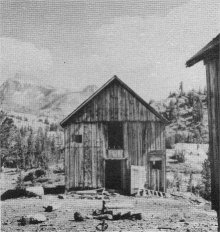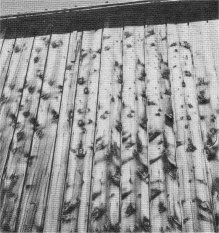
[click to enlarge]
WINTER NEAR BENNETTVILLE
| Online Library: | Title | Author | California | Geology | History | Indians | Muir | Mountaineering | Nature | Management |
Yosemite > Library > Ghost Mines > 15. The Going was Rough >
Next: 16. Great Sierra Wagon Road • Contents • Previous: 14. Stamps and Wire

[click to enlarge] WINTER NEAR BENNETTVILLE |
UNTIL THE CONSTRUCTION of the Great Sierra Wagon Road Bennettville and its environs were accessible only by trail. To the east Lundy was about 10 miles by Lake Canyon, 16 via Bloody Canyon. Yosemite Valley was 28 miles to the west, by a route much less precipitous than the eastern ones. In spite of difficulties and hardships hundreds of miners traveled these trails on foot, and many tons of supplies were packed in on the backs of men and animals. Some of their experiences were pathetic, others amusing:
Sometimes the going was easy:
T. Jeff McClelland, foreman of the Great Sierra Mine and Charley Benson . . . walked from Bennettville to Lundy on Saturday last, in two hours and three minutes—the fastest time on record. 40
Other times it was rough:
Yesterday Ben Dettmar and Tom Moore started for the Mount Dana [Mine, Tioga Hill] by way of Bloody Canyon. The route has not been tried this season that we know of. No matter how easy the new route may be we think Ben’s belly will prove too big a pack for him. He ought to sling it in a leather apron. 41 . . . Friends were considerably excited about the safety of the two men . . . J. T. Slack received a telegram from James Sumner, in Bodie: “Do all in your power for Moore and Dettmar. Act promptly.” Slack had organized a company to go in search of the missing men . . . when R. A. Sawyer and Jack Barrett arrived and reported that Dettmar and Moore had reached Tioga [16 miles from their starting point] safely, after wrestling five days with snow and starvation. Moore and Dettmar left King’s Station on Sunday morning, [January 27, 1881] and the same night their fire was seen on the summit. Next day they reached Fuller’s deserted cabin, where they remained until a break in the storm occurred, when they started again on their journey. They found in

[click to enlarge] FULLER’S CABIN DOOR |
Snowstorms were always a hazard:
December 10, 1881 — U. S. Mineral Surveyor H. B. Carpenter and Judge Harry P. Medlicott went over to Tioga on Friday of last week, to do some surveying for the Great Sierra Company. Saturday night the great snow storm set in and raged with varying fury of wind until Monday morning, the heaviest wind and tall of snow being during the afternoon of Sunday. About 10 a.m. of that day the two gentlemen named left the Great Sierra tunnel at the base of Tioga Hill, to ascend Mount Warren and follow its lofty backbone to the head of Lake Canyon, intending to descend that canyon and reach home the same evening. The deep glacial valley of Lee Vining Creek was crossed and the ascent of Mount Warren made in safety, but with much fatigue, the snow being deep, damp and soft, and constantly coming down in blinding clouds, while neither of the daring footmen were provided with snowshoes. From the point where the summer trail from Tioga reaches the summit, up to the “jumping off place” at the head of Lake Canyon, a distance of three miles or more, Mount Warren is a narrow, sharp, barren rocky ridge, nearly or quite 12,000 feet high, running parallel to the main summit of the Sierra, from which it is separated by a deep, glacial valley six or seven miles in width. As the lofty summit of the Sierra at this point is never free from snow, the winds swoop down from it, sweep across the valley and strike the summit of Mount Warren with tremendous force almost every day of the year; but when the Storm King of Winter is abroad in the Sierras and the snow is whirling through the air with a velocity of more than 100 miles per hour and a density so great that one cannot see his own feet, the scene is appalling, and more so as the eastern side of this sharp ridge, over which you may be hurled bodily at any moment, is a precipice of more than a thousand feet.

[click to enlarge] MOUNT WARREN DIVIDE (right); MOUNT CONNESS (left) |

[click to enlarge] BARN, ASSAY OFFICE, MOUNT DANA |

[click to enlarge] BENNETTVILLE FROM TUNNEL |
Such a storm Messrs. Carpenter and Medlicott found themselves in, on reaching the summit of Mount Warren Sunday afternoon. Fortunately the heavy wind had swept the snow from the ridge over the precipice, but the wind was so strong and the driving snow so dense that they were frequently compelled to stop, turn their backs to the storm and place their hands over their faces in order to get their breath. But the greatest danger was not encountered until they reached the depression where the wind sweeps with fearful velocity, breaking on the brow of the mountain, twisting and whirling in every direction and piling up snow in great ridges and mounds, so that, even if the atmosphere were clear, one could scarcely recognize the landmarks between which the trail winds down into the canyon with a frightful precipice on each side. When the worn-out and half-frozen men reached this point, late in the afternoon, the storm had redoubled its fury, the snow was blinding as Egyptian darkness and the atmosphere had become bitter cold. The men stopped. They could see nothing, and the roar and concussion of the wind impinging upon the mountain was painful to the ear, and the very earth trembled under the tread of the storm. A mistake here—a misstep—would be fatal, and as the men could not see their own arms’ length ahead of themselves they hesitated to proceed. But to hesitate was to be lost, for the atmosphere at this point and at that hour of the day was so intensely cold, with the tempest piercing through their soaked and frozen clothes, that they could not possibly survive ten minutes. The trail curves sharply to the right as it leaves the summit to descend into the canyon. This they knew, but how to follow its course without a single landmark in sight, and avoid the precipice on the left, down which they might plunge into Lake Oneida, a mile below, in a minute, and to avoid the lofty vertical slate wall on the right, over which they might drop several hundred feet into the head of the “wash” below, this was the question. During a momenary flash of daylight through the driving snow, Judge Medlicott thought he recognized a point of rocks about which he had been surveying a year or two ago; but the apparition instantly vanished. Surveyor Carpenter started ahead, leading Medlicott so that they might keep together (the blind leading the blind), cautiously curving his course to the right as he went, but directly he wind picked him up and whirled him around and around ‘till he didn’t know whether he was following the curved line of beauty or the straight line of duty.,. As he “lit”, however, he uttered an exclamation of joy calling to his companion that they were all right. He had found a little forked stick fastened in a projecting rock, which he recognized as being on the line of the trail and below the point of danger from the precipice. Three hours more wallowing through the deep and heavy snow brought them into town, just before dark, with Carpenter still lively as a chipmunk but Judge Medlicott “a little the worse for wear”—both elaborately ornamented with icicles that jingled as merrily as sleigh bells. 43
Even skis can have their drawbacks, as a rescue team bringing a frost-bitten miner named Seymour from Bennettville to Lundy learned the hard way:
Fortunately the descent was made without serious consequences; but the worse was yet to come. One man had been detailed to take care of the eleven pairs of snow shoes, and to bring them down after the others had reached the canyon below. The shoes were all of the Norwegian pattern, varying in length from eight to eleven feet, and had been lashed together in a bundle for the descent. The man in charge had scarcely got started, however, before the bundle broke loose, and away went the 22 shoes, scampering over the precipice like a band of buffalo on a stampede. As the alarm was given and the men below looked up and saw the shower of shoes coming over the cliff, they too stampeded—all save Seymour, who was lashed to the sled and had to take the consequences. The shoes flitted by like arrows from a strong bow, missing the men but scattering in all directions through the timber and underbrush in the canyon—nearly every shoe being broken. This left the expedition in a crippled condition. The snow down the canyon was very deep and soft, the brush and huge boulders difficult to get through, and night was coming on and the cold was intense. . . . After a long search all of the broken snow shoes were found and patched up so that they could be used. . . . 44
The group made it to camp, half-frozen but safe.

[click to enlarge] WALL OF BARN, BENNETTVILLE |

[click to enlarge] GREAT SIERRA CABIN, TIOGA HILL |
Sometimes there were unanticipated hazards:
C. W. Curtis and Fred McLaughlin, in descending Mount Warren to Lee Vining Creek on their way to Bennett City on Monday last, passed a large black or cinnamon bear, sitting up about 100 feet from the trail, in the scattering timber that skirts the mountain. The two men, as is of one mind, concluded to have a snowshoe race from that point down to the valley at once. . . . Fred darted down through the forest like a wild pigeon and almost instantly disappeared. Curtis got a fair start, and was not scared, but his snowshoes got frightened at the bear and bucked him off into the deep, soft snow, and while he was floundering down the hill in breathless haste, with one eye on the bear and the other on McLaughlin’s trail, old Bruin sat, with arms folded, looking down on him with a placed, partronizing sort of smile. 45
Even cattle were driven over the trails, not always with success:
Burkham’s circus gave an entertainment up on Tioga Hill last Sunday, The band of wild beef cattle driven over to be butchered for the Great Sierra Mining Company was abandoned in the valley of Lee Vining Creek Saturday evening and the men ascended the mountain to camp to spend the night. Sunday morning Burkham and his assistants descended to the valley early and got the cattle up to the mine in good season; but as soon as the first cow was shot the remainder of the herd scampered off in all directions, and when the last one was killed the summit of the Sierra was covered with beef for a radius of four miles! 46
Next: 16. Great Sierra Wagon Road • Contents • Previous: 14. Stamps and Wire
| Online Library: | Title | Author | California | Geology | History | Indians | Muir | Mountaineering | Nature | Management |
http://www.yosemite.ca.us/library/ghost_mines/rough_going.html